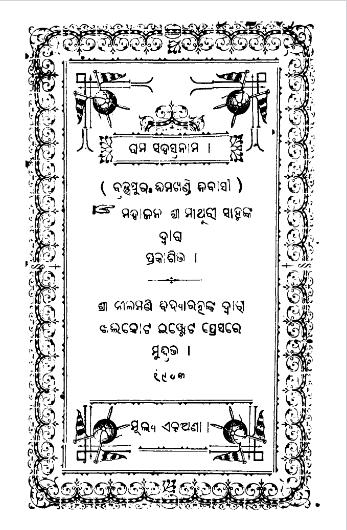In the annals of Odia literature, the year 1903 marks the publication of a remarkable poetic work, Rama Sahasranama. This profound text is a tribute to Lord Rama, the central figure of the Hindu epic Ramayana, and it holds a significant place in the spiritual and cultural heritage of Odisha. Through its rich verses and thematic depth, Rama Sahasranama transcends mere poetry and becomes a spiritual compass, inviting readers to delve into the qualities and virtues embodied by Lord Rama.
The title Rama Sahasranama translates to “The Thousand Names of Rama,” and it emphasizes the many facets of the divine figure. The text comprises a collection of verses, each highlighting different attributes, stories, and ideals associated with Rama, ultimately painting a holistic picture of his character as an ideal man and king. The structure of the work invites readers not just to appreciate the poetic form but to engage in a spiritual practice, reflecting on the significance of each name and the qualities it represents.
Written by an anonymous poet, Rama Sahasranama is remarkable for its lyrical beauty and lyrical style. The use of rhythmic patterns and alliteration enriches the text, making it a pleasure to read aloud or recite. Such melodic qualities are pivotal in devotional poetry, as they facilitate memorization and chant, allowing the verses to resonate in the hearts and minds of devotees. The poem becomes not just a reading experience, but an integral part of devotional practices, bridging the gap between literature and spirituality.
Through its verses, the Rama Sahasranama encapsulates the essence of dharma (righteousness) and the virtues associated with Lord Rama, such as truth, love, loyalty, and valor. Each name serves as a reminder of the qualities that individuals aspire to embody in their own lives. In a world often fraught with ethical dilemmas and moral uncertainties, the text provides a guiding light, encouraging readers to embrace righteousness and live with integrity.
Another important aspect of Rama Sahasranama is its reflection on the historical and cultural context of Odisha during the early 20th century. At a time when India was undergoing significant social and political changes, the text offers a spiritual anchor. It resonates with a collective desire for identity and purpose, urging readers to find strength in their cultural and spiritual roots. The return to traditional values depicted through the veneration of Rama fosters a sense of community and continuity, reinforcing the importance of cultural heritage.
Moreover, Rama Sahasranama serves as a vehicle for cultural preservation, showcasing the richness of the Odia language and literary tradition. The poetic expressions not only celebrate the divine but also elevate the linguistic and cultural attributes of Odisha, fostering pride in regional identity. The careful choice of language and imagery reflects the beauty of Odia literature, making it accessible and engaging for readers across generations.
As we reflect on the enduring legacy of Rama Sahasranama, it becomes apparent that it is more than just a poetic tribute to a divine figure. It is a celebration of values that resonate deeply within the human experience. The verses encourage individuals to seek inner strength, strive for righteousness, and build connections with their spiritual heritage.
Books Info
| Books name | Rama Sahasranama / ରାମ ସହଶ୍ରନାମ |
| Author | NA |
| No Of pages | 18 |
| Publisher | NA |
| Publication | 1903 |
| Printed At | Khalicot Etsat Press |
| Distributor | NA |

